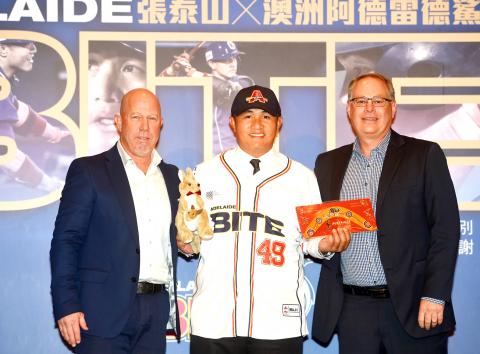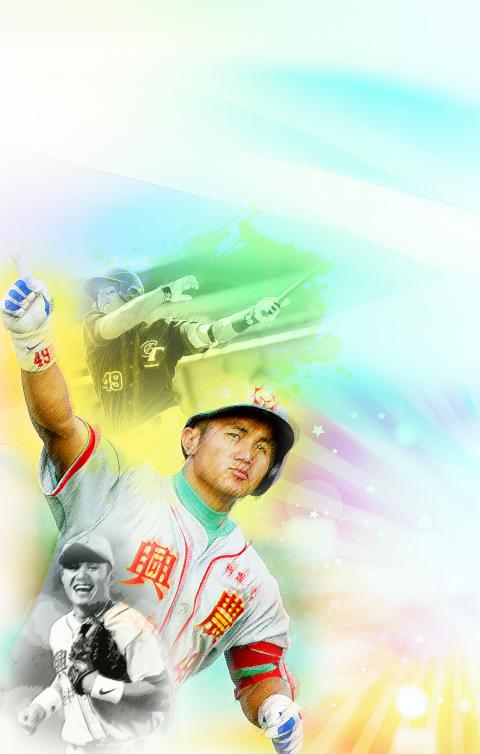In January 2014, everything seemed to be going well between the Uni-President Lions and Chang Tai-shan (張泰山). Chang was in top form and with a salary raise and a renewed contract, it seemed the club was going to stay the course with him. But soon the management’s intentions became clear — move him to the coaching bench. He refused and left at the end of 2015 to play in Japan.
“I figured, if that’s how they treat me as a player, how is it going to be as their coach?” Chang, 40, says.
Two decades spent smashing records in a career spanning the golden days of Taiwanese baseball, the Home-run King (全壘打王) — 289 in 20 years — is as admired for his longevity as his prodigious batting swing. But the legend has been denied a fitting send off. Sick of being lead on by clubs that sign him up with a plan to have him join the coaching bench, Chang has resolved to go out on his own terms, and head to Australia to make his last stand in the batter’s box for the Adelaide Bite. He starts with the team next month.

Photo: Fang pin-chao, Taipei Times
I’m riding shotgun in Chang’s car. It’s another wet cloudy day in Taoyuan as we make our way to his local training spot, National Taiwan Sport University.

illustration: kevin sheu
“Aging’s a double-edged sword,” he says. “My reaction speed is slowing, but then I have years and years of experience. It’s about making sure one makes up for other.”
Rain drums on the bonnet of the car.
“In the US, they won’t force you into retirement early. If you’re still going strong they’ll let you go as long as you can. It’s different here though, they don’t value senior players,” he says.
But you can’t force it. If you can’t keep up, you’ve got to stop, or else it’s disrespectful to the other players and the fans, he says.
“All I want is [that same] respect,” he adds.
It’s a shame that Chang isn’t keen to coach, because he has a natural talent for it.
We pull up outside the facility. Chang enters the weights room and the huge men pause, turn toward him and beam boyish grins — they’d probably salute him if they didn’t have 20kg weights in thier hands.
“Keep at it,” Chang says as we head to the hitting nets out back.
‘IRREPLACEABLE’
“Most players at his age are happy to retire, go off and do their own thing,” one player for the National Taiwan Sport University tells the Taipei Times.
“He’s irreplaceable,” he adds.
Chang is inspecting the swings of a group of young batters. They take it in turns to hit off from a tee before Chang gets up to show them how it’s done.
Today’s lesson is about the swivel of the hips.
“The power comes from here,” he says, patting his stomach.
Huddled around on the synthetic turf, they look up at him with a fixed gaze, hanging on every word.
I wait for the moment when Chang’s little coaching session will end and his own training will begin, but I realize after a while that it’s not coming. He doesn’t work that way.
Alternating between pitching and batting, he trains alongside the younger players all afternoon.
HOME-RUN PRINCE
The sound of child playing can be heard as we approach the front door of Chang’s home. His entrance is met again with great fanfare, the kids bounce off the sofa in excitement. A baseball whizzes by. I notice the wall nearest me is peppered with marks and patches. Chang’s son has recently started practicing his throw.
“When I told my boy I have to retire he asked me, ‘Dad, what’s retirement?’ I explained and he said, ‘But I want to see you keep playing,’” Chang says.
“I can’t let him down.”
Chang says his family couldn’t afford much meat when he was a kid, so he used to trap squirrels and sugar gliders instead.
“I got into baseball for the food,” he quips.
The pitch-side vendor used to offer them a hundred sausages per home run as good play brought more customers, Chang says.
“But my son has come to baseball from me,” he says, watching his children play.
Chang says he’ll teach him all he knows, but won’t force him to outdo his father.
“As long as he’s happy playing, that’s what matters.”

Taiwan Power Co (Taipower, 台電) and the New Taipei City Government in May last year agreed to allow the activation of a spent fuel storage facility for the Jinshan Nuclear Power Plant in Shihmen District (石門). The deal ended eleven years of legal wrangling. According to the Taipower announcement, the city government engaged in repeated delays, failing to approve water and soil conservation plans. Taipower said at the time that plans for another dry storage facility for the Guosheng Nuclear Power Plant in New Taipei City’s Wanli District (萬里) remained stuck in legal limbo. Later that year an agreement was reached

What does the Taiwan People’s Party (TPP) in the Huang Kuo-chang (黃國昌) era stand for? What sets it apart from their allies, the Chinese Nationalist Party (KMT)? With some shifts in tone and emphasis, the KMT’s stances have not changed significantly since the late 2000s and the era of former president Ma Ying-jeou (馬英九). The Democratic Progressive Party’s (DPP) current platform formed in the mid-2010s under the guidance of Tsai Ing-wen (蔡英文), and current President William Lai (賴清德) campaigned on continuity. Though their ideological stances may be a bit stale, they have the advantage of being broadly understood by the voters.

In a high-rise office building in Taipei’s government district, the primary agency for maintaining links to Thailand’s 108 Yunnan villages — which are home to a population of around 200,000 descendants of the Chinese Nationalist Party (KMT) armies stranded in Thailand following the Chinese Civil War — is the Overseas Community Affairs Council (OCAC). Established in China in 1926, the OCAC was born of a mandate to support Chinese education, culture and economic development in far flung Chinese diaspora communities, which, especially in southeast Asia, had underwritten the military insurgencies against the Qing Dynasty that led to the founding of

Artifacts found at archeological sites in France and Spain along the Bay of Biscay shoreline show that humans have been crafting tools from whale bones since more than 20,000 years ago, illustrating anew the resourcefulness of prehistoric people. The tools, primarily hunting implements such as projectile points, were fashioned from the bones of at least five species of large whales, the researchers said. Bones from sperm whales were the most abundant, followed by fin whales, gray whales, right or bowhead whales — two species indistinguishable with the analytical method used in the study — and blue whales. With seafaring capabilities by humans